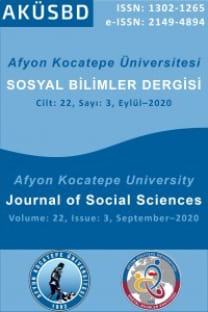Türkçe Öğretmeni Adaylarının Osmanlı Türkçesi Dersine Yönelik Öğrenen Güçlenmesi Düzeyleri
Bu çalışmada, Türkçe öğretmeni adaylarının Osmanlı Türkçesi dersine yönelik öğrenen güçlenmesi düzeyleri cinsiyet ve sınıf değişkenleri açısından incelenmiştir. Araştırma, 2017-2018 eğitim-öğretim yılının bahar döneminde Dicle Üniversitesi Ziya Gökalp Eğitim Fakültesi Türkçe Eğitimi Ana Bilim Dalı’nda öğrenim gören toplam 167 öğrencinin katılımı ile gerçekleştirilmiştir. Araştırmada, katılımcıların Osmanlı Türkçesi dersine yönelik öğrenen güçlenmesi düzeylerinin belirlenmesi amacıyla Frymier, Shulman ve Houser (1996) tarafından geliştirilen, Çakır ve Erdoğan (2014) tarafından Türkçeye uyarlanan “Öğrenen Güçlenmesi Ölçeği” kullanılmıştır. Araştırma sonucunda, cinsiyet ve sınıf değişkenleri açısından öğretmen adaylarının öğrenen güçlenmesi düzeylerinin “etki”, “anlamlılık” ve “yeterlilik” boyutlarına göre istatistiksel açıdan anlamlı düzeyde farklılık göstermediği belirlenmiştir. Elde edilen bulgular sonucunda Türkçe öğretmeni adaylarının Osmanlı Türkçesi dersinde yapacakları faaliyetleri belirleyebildiği ve derste takdir edildikleri, Osmanlı Türkçesi dersinde edindikleri bilgileri ve yerine getirmeleri gereken görevleri anlamlı buldukları, Osmanlı Türkçesi dersi ile ilgili görevleri layıkıyla yerine getirebilme konusunda kendilerine güvendikleri, bu derste başarılı olmak için gerekli niteliklere sahip olduklarını düşündükleri sonucuna ulaşılmıştır.
Learner Empowerment Levels of Pre-Service Turkish Teachers Towards Ottoman Turkish Course
In this study, learner empowerment levels of pre-service Turkish teachers towards Ottoman Turkish course was examined in terms of gender and class variables. The research was conducted with the participation of a total of 167 students studying at the Department of Turkish Language Teaching at Ziya Gökalp Education Faculty of Dicle University in the spring semester of 2017-2018 academic year. In the study, "Learner Empowerment Scale" developed by Frymier, Shulman and Houser (1996) and adapted to Turkish by Çakır and Erdoğan (2014) was used in order to determine the level of learner empowerment for the Ottoman Turkish course. As a result of the research, it was determined that the level of the learner empowerment in terms of gender and class variables did not differ statistically according to the dimensions of "impact", "significance" and "adequacy". As a result of the findings, it is found that pre-service Turkish teachers are able to determine the activities they will perform in the Ottoman Turkish course and they are appreciated, they find task meaningful in the course and fulfill the tasks they need to fulfill; they are confident in fulfilling their duties related to the Ottoman Turkish course and the qualities they have achieved.
___
- Block, P. (1987). The Enpowered Manager: Positive Political Skills at Work. San Francisco: Jossey-Bass.
- Brooks, F. C. ve Young, S. L. (2001). Are Choice-Making Opportunities Needed in The Classroom? Using Self-Determination Theory to Consider Student Motivation and Learner Empowerment. International Journal of Teaching and Learning in Higher Education, 23(1): 48-59.
- Conger, J. ve Kanungo, R. (1988). The Empowerment Process: Integrating Theory and Practice. Academy of Management Review, 13: 471-482.
- Çakır, S. G. ve Erdoğan, M. (2014). “Öğrenen Güçlenmesi Ölçeğinin Uyarlanması: Geçerlik ve Güvenirlik Çalışmaları”, Mustafa Kemal Üniversitesi Sosyal Bilimler Enstitüsü Dergisi, 11(25): 297-307.
- Çalışkan, N. (2013). Lise Düzeyindeki Osmanlı Türkçesi Dersi Öğretim Programı’nın Uygulanışına İlişkin Öğrenci Görüşlerine Dayalı Bir Değerlendirme, Bartın Üniversitesi Eğitim Fakültesi Dergisi, 2(2): 329-343.
- Frymier, A. B. ve Houser, M. L. (1999). The Revised Learning Indicators Scale. Communication Studies, 50(1): 1-12.
- Frymier, A. B., Shulman, G. M. ve Houser, M. (1996). The Development of a Learner Empowerment Measure. Communication Education, 45: 181-199.
- Guay, F., Vallerand, R. J. ve Blanchard, C. (2000). On the Assessment of Situational Intrinsic and Extrinsic Motivation: The Situational Motivation Scale (SIMS). Motivation and Emotion, 24(3): 175-213.
- Houser, M. L. ve Frymier, A. B. (2009). The Role of Student Characteristics and Teacher Behaviors in Students’ Learner Empowerment, Communication Education, 58(1): 35-53.
- Luechauer, D. ve Shulman, G. M. (1993). Empowerment at Work: Separating Folklore from Fact”. At Work: Stories of Tomorrow's Workplace, 2(6): 13-14.
- Schrodt, P., Witt, P. L., Myers, S. A., Turman, P. D., Barton, M. H. ve Jernberg, K. A. (2008). Learner Empowerment and Teacher Evaluations as Functions of Teacher Power Use in the College Classroom. Communication Education, 57(2): 180-200.
- Senge, P. (1990). The Fifth Dicipline: The Art and Practice of Learning Organizations. New York: Currency Doubleday.
- Thomas, K., ve Velthouse, B. (1990). Cognitive Elements of Empowerment: An Interpretive Model of Intrinsic Task Motivation. Academy of Management Review, 15: 666-681.
- Weber, K. ve Patterson, B. R. (2000). Student Interest, Empowerment and Motivation. Communication Research Reports, 17: 22-29.
- Zimmerman, M. A. (1990). Toward a Theory of Learned Hopefulness: A Structural Model Analysis of Participation and Empowerment. Journal of Research in Personality, 24: 71-86.
- ISSN: 1302-1265
- Yayın Aralığı: Yılda 4 Sayı
- Başlangıç: 1999
- Yayıncı: Afyon Kocatepe Üniversitesi Sosyal Bilimler Enstitüsü
Sayıdaki Diğer Makaleler
Türkçe Öğretmeni Adaylarının Osmanlı Türkçesi Dersine Yönelik Öğrenen Güçlenmesi Düzeyleri
Ahmet BAŞKAN, Hatice ALTUNKAYA
Faaliyet Kaldıraç Derecesinin Satış Gelirleri Üzerindeki Etkisi: Havayolu Şirketlerinde Bir Uygulama
Türkiye’de Finansal Krizlerin Öncü Göstergelerle Tahmini
Uzay Turizmine İlişkin Uluslararası Turizm Karikatürlerinin Göstergebilimsel Bir Analizi
Sosyal Medya Uygulamalarını Kullanmaya Yönelik Niyetin Belirleyicileri
Fatih ŞAHİN, Alkan ALKAYA, Ercan TAŞKIN
Hediye ve Hediye Satın Alma Davranışları
Reklamlarda Metaforik Öğelerin Kullanımı: Kozmetik Reklamları Örneği
